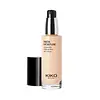What's inside
What's inside
 Key Ingredients
Key Ingredients

 Benefits
Benefits

 Concerns
Concerns

 Ingredients Side-by-side
Ingredients Side-by-side

Water
Skin ConditioningSynthetic Fluorphlogopite
Mica
Cosmetic ColorantLauryl Dimethicone
Skin ConditioningButyrospermum Parkii Butter
Skin ConditioningButylene Glycol
HumectantHydrogenated Polycyclopentadiene
Glycerin
HumectantIsododecane
EmollientAmmonium Acryloyldimethyltaurate/Beheneth-25 Methacrylate Crosspolymer
Emulsion StabilisingPolyglyceryl-4 Caprate
EmulsifyingPolyglyceryl-3 Polyricinoleate
EmulsifyingHydroxyacetophenone
AntioxidantPanthenol
Skin ConditioningPhenoxyethanol
PreservativeSilica
AbrasiveHydrogenated Lecithin
EmulsifyingSimethicone
EmollientAscorbyl Palmitate
AntioxidantTocopherol
AntioxidantPolyglyceryl-3 Diisostearate
EmulsifyingHydrolyzed Vegetable Protein
Skin ConditioningKaolin
AbrasiveCI 77491
Cosmetic ColorantCI 77492
Cosmetic ColorantCI 77499
Cosmetic ColorantCI 77891
Cosmetic ColorantCI 77007
Cosmetic ColorantWater, Synthetic Fluorphlogopite, Mica, Lauryl Dimethicone, Butyrospermum Parkii Butter, Butylene Glycol, Hydrogenated Polycyclopentadiene, Glycerin, Isododecane, Ammonium Acryloyldimethyltaurate/Beheneth-25 Methacrylate Crosspolymer, Polyglyceryl-4 Caprate, Polyglyceryl-3 Polyricinoleate, Hydroxyacetophenone, Panthenol, Phenoxyethanol, Silica, Hydrogenated Lecithin, Simethicone, Ascorbyl Palmitate, Tocopherol, Polyglyceryl-3 Diisostearate, Hydrolyzed Vegetable Protein, Kaolin, CI 77491, CI 77492, CI 77499, CI 77891, CI 77007
Water
Skin ConditioningDimethicone
EmollientIsohexadecane
EmollientEthylhexyl Methoxycinnamate
UV AbsorberPhenyl Trimethicone
Skin ConditioningMica
Cosmetic ColorantPolymethylsilsesquioxane
Caprylyl Dimethicone Ethoxy Glucoside
EmulsifyingTitanium Dioxide
Cosmetic ColorantCocoglycerides
EmollientButylene Glycol
HumectantSorbitan Isostearate
EmulsifyingDimethicone Crosspolymer
Emulsion StabilisingAluminum/Magnesium Hydroxide Stearate
Emulsion StabilisingGlycerin
HumectantPhenoxyethanol
PreservativeSodium Chloride
MaskingCaprylic/Capric Triglyceride
MaskingZinc Stearate
Cosmetic ColorantSilica Silylate
EmollientPotassium Sorbate
PreservativeSodium Dehydroacetate
PreservativeTocopheryl Acetate
AntioxidantDisodium EDTA
Carthamus Tinctorius Seed Oil
MaskingAloe Barbadensis Leaf Extract
EmollientRubus Idaeus Leaf Extract
Skin ConditioningCI 77891
Cosmetic ColorantCI 77491
Cosmetic ColorantWater, Dimethicone, Isohexadecane, Ethylhexyl Methoxycinnamate, Phenyl Trimethicone, Mica, Polymethylsilsesquioxane, Caprylyl Dimethicone Ethoxy Glucoside, Titanium Dioxide, Cocoglycerides, Butylene Glycol, Sorbitan Isostearate, Dimethicone Crosspolymer, Aluminum/Magnesium Hydroxide Stearate, Glycerin, Phenoxyethanol, Sodium Chloride, Caprylic/Capric Triglyceride, Zinc Stearate, Silica Silylate, Potassium Sorbate, Sodium Dehydroacetate, Tocopheryl Acetate, Disodium EDTA, Carthamus Tinctorius Seed Oil, Aloe Barbadensis Leaf Extract, Rubus Idaeus Leaf Extract, CI 77891, CI 77491
Ingredients Explained
These ingredients are found in both products.
Ingredients higher up in an ingredient list are typically present in a larger amount.
Butylene Glycol (or BG) is used within cosmetic products for a few different reasons:
Overall, Butylene Glycol is a safe and well-rounded ingredient that works well with other ingredients.
Though this ingredient works well with most skin types, some people with sensitive skin may experience a reaction such as allergic rashes, closed comedones, or itchiness.
Learn more about Butylene GlycolCi 77491 is also hydrated iron III oxide. It's sole purpose is to give a red/pink hue to products.
Iron III oxides are classified as inorganic chemicals for coloring.
Synthetically created Ci 77491 is considered safer than those naturally found. This is because the synthetically created version may contain less impurities. Iron oxides are generally non-toxic and non-allergenic.
Learn more about CI 77491Ci 77891 is a white pigment from Titanium dioxide. It is naturally found in minerals such as rutile and ilmenite.
It's main function is to add a white color to cosmetics. It can also be mixed with other colors to create different shades.
Ci 77891 is commonly found in sunscreens due to its ability to block UV rays.
Learn more about CI 77891Glycerin is already naturally found in your skin. It helps moisturize and protect your skin.
A study from 2016 found glycerin to be more effective as a humectant than AHAs and hyaluronic acid.
As a humectant, it helps the skin stay hydrated by pulling moisture to your skin. The low molecular weight of glycerin allows it to pull moisture into the deeper layers of your skin.
Hydrated skin improves your skin barrier; Your skin barrier helps protect against irritants and bacteria.
Glycerin has also been found to have antimicrobial and antiviral properties. Due to these properties, glycerin is often used in wound and burn treatments.
In cosmetics, glycerin is usually derived from plants such as soybean or palm. However, it can also be sourced from animals, such as tallow or animal fat.
This ingredient is organic, colorless, odorless, and non-toxic.
Glycerin is the name for this ingredient in American English. British English uses Glycerol/Glycerine.
Learn more about GlycerinMica is a naturally occurring mineral used to add shimmer and color in cosmetics. It can also help improve the texture of a product or give it an opaque, white/silver color.
Serecite is the name for very fine but ragged grains of mica.
This ingredient is often coated with metal oxides like titanium dioxide. Trace amounts of heavy metals may be found in mica, but these metals are not harmful in our personal products.
Mica has been used since prehistoric times throughout the world. Ancient Egyptian, Indian, Greek, Roman, Aztec, and Chinese civilizations have used mica.
Learn more about MicaPhenoxyethanol is a preservative that has germicide, antimicrobial, and aromatic properties. Studies show that phenoxyethanol can prevent microbial growth. By itself, it has a scent that is similar to that of a rose.
It's often used in formulations along with Caprylyl Glycol to preserve the shelf life of products.
Water. It's the most common cosmetic ingredient of all. You'll usually see it at the top of ingredient lists, meaning that it makes up the largest part of the product.
So why is it so popular? Water most often acts as a solvent - this means that it helps dissolve other ingredients into the formulation.
You'll also recognize water as that liquid we all need to stay alive. If you see this, drink a glass of water. Stay hydrated!
Learn more about Water